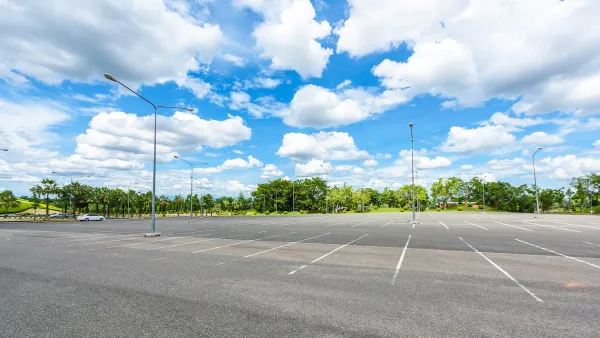Historic planning documents, like those found in the APA's Planning Advisory Service, are full of lessons about how past planning doctrines failed their intentions, and it's always a good time for planners to re-evaluate their antecedents.
Chuck Marohn responds to a January 1954 report detailing site design, parking, and zoning recommendations for shopping centers. (The American Planning Association released the report to honor of the history of their Planning Advisory Service, which has offered planning expertise since 1949.)
"Understanding this was the beginning of the heyday of relevance and influence of the planning profession -- a 15 to 20 year period that ended with the failures of urban renewal, the natural trajectory of this intellectual mentality -- it's fascinating to read the logic employed here," writes Marohn.
So along those lines there's some good news and there's some bad news. To start with the bad news, the report prioritizes parking over the value of the land. To quote from the report:
The shopper wants a space he can find easily, with a minimum of difficulty in moving around the parking area, and one that is located near the store or store group in which he is going to shop. The fault is sometimes with the developers who have underestimated the need for parking space or found the land too valuable to be devoted to parking.
As for the good news, Marohn also notes that the report shares some valuable insight that has been lost over the years, like how parking requirements shouldn't be one-size-fits-all. Also to quote from the report:
..there will be more walk-in business in a neighborhood shopping center than in a community or regional shopping center, and therefore the smaller center will not require proportionately as much off-street parking space as the large center.
Hat tip to Angie Schmitt at Streetsblog USA for sharing news of Marohn's post.
FULL STORY: CAN YOU HAVE TOO MUCH PARKING?

Analysis: Cybertruck Fatality Rate Far Exceeds That of Ford Pinto
The Tesla Cybertruck was recalled seven times last year.

National Parks Layoffs Will Cause Communities to Lose Billions
Thousands of essential park workers were laid off this week, just before the busy spring break season.

Retro-silient?: America’s First “Eco-burb,” The Woodlands Turns 50
A master-planned community north of Houston offers lessons on green infrastructure and resilient design, but falls short of its founder’s lofty affordability and walkability goals.

Test News Post 1
This is a summary

Analysis: Cybertruck Fatality Rate Far Exceeds That of Ford Pinto
The Tesla Cybertruck was recalled seven times last year.

Test News Headline 46
Test for the image on the front page.
Urban Design for Planners 1: Software Tools
This six-course series explores essential urban design concepts using open source software and equips planners with the tools they need to participate fully in the urban design process.
Planning for Universal Design
Learn the tools for implementing Universal Design in planning regulations.
EMC Planning Group, Inc.
Planetizen
Planetizen
Mpact (formerly Rail~Volution)
Great Falls Development Authority, Inc.
HUDs Office of Policy Development and Research
NYU Wagner Graduate School of Public Service




























